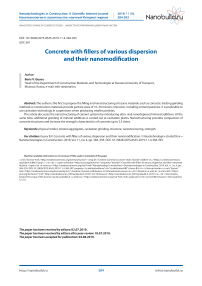Concrete with fillers of various dispersion and their nanomodification
Автор: Gusev B.V.
Журнал: Nanotechnologies in Construction: A Scientific Internet-Journal @nanobuild-en
Рубрика: Cement system nanostructuring
Статья в выпуске: 4 Vol.11, 2019 года.
Бесплатный доступ
The author is the first to propose the filling and nanostructuring of coarse materials such as concrete. Existing grinding methods in construction materials provide particle sizes of 10–50 microns (microns), including cement particles. It is preferable to use cavitation technology in suspensions when producing smaller particles. The article discusses the nanostructuring of cement systems by introducing ultra- and nanodispersed mineral additives. At the same time, additional grinding of mineral additives is carried out at cavitation plants. Nanostructuring provides compaction of concrete structures and increase the strength characteristics of concrete up to 2.5 times.
Physical model, mineral aggregates, cavitation grinding, structure, nanostructuring, strength
Короткий адрес: https://sciup.org/142227472
ID: 142227472 | DOI: 10.15828/2075-8545-2019-11-4-384-393
Список литературы Concrete with fillers of various dispersion and their nanomodification
- Gusev B.V. Razvitie nanonauki i nanotehnologij [The development of nanoscience and nanotechnology]. Mezhdunarodnaja nauchno-tehnicheskaja konferencija «Kompozicionnye stroitel’nye materialy. Teorija i praktika» [International scientific and technical conference «Composite building materials. Theory and practice»]. Penza, Volga House of Knowledge, 2007, p. 70–73.(In Russian).
- Melekhov I.V. Fiziko-himicheskaja jevoljucija tverdogo veshhestva (nanotechnologia) [Physical and chemical evolution of solids (nanotechnology)]. Moscow, Publishing House «BINOM. Laboratory of Knowledge», 2006. 309 p. (In Russian).
- Shabanova N.A., Popov V.V., Sarkisov P.D. Himija i tehnologija nanodispersnyh oksidov [Chemistry and technology of nanosized oxides]. Moscow, Academic Book, 2007. 309 p. (In Russian).
- Generalov M.B. Kriohimicheskajananotehnologija [Cryochemical nanotechnology]. Moscow. Akademkniga, 2006. 332 p.
- Blinkov I.V., Manukhin A.V. Nanodispersnye i granulirovannye materialy, poluchennye v impul’sivnoj plazme [Nanodispersed and granular materials obtained in impulsive plasma]. Moscow, MISIS, 2005. 367 p. (In Russian).
- Gusev B.V., Galkina T.Yu. Vibracionno-impul’snyj sposob prigotovlenija trudno smeshivaemyh s vodoj dobavok [Vibrationpulse method of preparation of additives difficult to mix with water]. Beton i zhelezobeton [Concrete and reinforced concrete]. 1983. No. 12. P. 13–14. (In Russian).
- Li G.Y., Wang P.M., Zhao X. Mechanical behavior and microstructure of cement composites incorporating surface-treated multi-walled carbon nanotubes. Carbon. 2005. Vol. 43. P. 1239–1245.
- Konsta-Gdoutos M.S., Metaxa Z.S., Shah S.P. Highly dispersed carbon nanotube reinforced cement based materials. Cement and Concrete Research. 2010. Vol. 40. P. 1052–1059.
- Gusev B.V., Minsadrov I.N., Selivanov N.P. Nanovjazhushhie [Nanobinders]. Russian Federation Patent No. 2412919. 2009. (In Russian).
- Gusev B.V. Perspektivnye tehnologii pri proizvodstve sbornogo zhelezobetona [Promising technologies in the production of precast concrete]. Monograph. 2nd Edition. Izhevsk 2015, 206 p. (In Russian).
- Gusev B.V., Falikman V.G. Concrete and reinforced concrete in the era of sustainable development. Promyshlennoe i grazhdanskoe stroitel’stvo [Industrial and Civil Engineering]. 2016. № 2. P. 30‒38. (In Russian).


